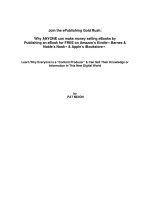Leadership the Hard Way: Why Leadership Can’t Be Taught and How You Can Learn It Anyway
Bạn đang xem bản rút gọn của tài liệu. Xem và tải ngay bản đầy đủ của tài liệu tại đây (1.07 MB, 157 trang )
Leadership the
Hard Way
Why Leadership Can’t Be Taught and
How You Can Learn It Anyway
by Dov Frohman
with Robert Howard
ffirs.indd viiffirs.indd vii 2/2/08 10:52:58 AM2/2/08 10:52:58 AM
ffirs.indd iiffirs.indd ii 2/2/08 10:52:57 AM2/2/08 10:52:57 AM
More Praise for Leadership the Hard Way
“Dov Frohman is a giant of Israeli high tech. His book isn’t only
about leadership, it is about the human spirit and how high it can
soar. Frohman and Howard capture the expansive vision and non-
stop creativity that have made Israel one of the most advanced
centers of high-tech innovation in the world.”
—Yossi Vardi, chairman, International Technologies;
founding investor, Mirabillis Ltd., creator of ICQ
“From an early age, Frohman learned to transform fear of survival
into courageous action. Some lessons for leaders: stick to your
principles, welcome intelligent dissent, take time to daydream but
then make your dreams real. This book will stimulate you to refl ect
on your practice of leading people.”
—Michael Maccoby, author of The Gamesman and The Leaders
We Need, And What Makes Us Follow
“Dov Frohman distills thirty years of experience on the front lines
of the global economy—from Silicon Valley to Israel—in this
beautifully written and compelling narrative. His wisdom is not
just for business leaders, it’s for anyone seeking to lead in today’s
tumultuous environment.”
—AnnaLee Saxenian, dean of the School of Information,
UC Berkeley; author of The New Argonauts: Regional
Advantage in a Global Economy
ffirs.indd iffirs.indd i 2/2/08 10:52:56 AM2/2/08 10:52:56 AM
ffirs.indd iiffirs.indd ii 2/2/08 10:52:57 AM2/2/08 10:52:57 AM
Leadership the Hard Way
ffirs.indd iiiffirs.indd iii 2/2/08 10:52:57 AM2/2/08 10:52:57 AM
ffirs.indd ivffirs.indd iv 2/2/08 10:52:57 AM2/2/08 10:52:57 AM
A WARREN BENNIS BOOK
This collection of books is devoted exclusively to new
and exemplary contributions to management thought
and practice. The books in this series are addressed to
thoughtful leaders, executives, and managers of all
organizations who are struggling with and committed
to responsible change. My hope and goal is to spark
new intellectual capital by sharing ideas positioned at
an angle to conventional thought—in short, to publish
books that disturb the present in the service of a
better future.
ffirs.indd vffirs.indd v 2/2/08 10:52:57 AM2/2/08 10:52:57 AM
Books in the Warren Bennis Signature Series
Branden
Self-Esteem at Work
Mitroff, Denton
A Spiritual Audit of Corporate
America
Schein
The Corporate Culture
Survival Guide
Sample
The Contrarian’s Guide to
Leadership
Lawrence, Nohria
Driven
Cloke, Goldsmith
The End of Management and
the Rise of Organizational
Democracy
Glen
Leading Geeks
Cloke, Goldsmith
The Art of Waking People Up
George
Authentic Leadership
Kohlrieser
Hostage at the Table
Rhode
Moral Leadership
George
True North
Townsend
Up the Organization
Kellerman/Rhode
Women and Leadership
Riggio
The Art of Followership
Gergen/Vanourek
Life Entrepreneurs
ffirs.indd viffirs.indd vi 2/2/08 10:52:58 AM2/2/08 10:52:58 AM
Leadership the
Hard Way
Why Leadership Can’t Be Taught and
How You Can Learn It Anyway
by Dov Frohman
with Robert Howard
ffirs.indd viiffirs.indd vii 2/2/08 10:52:58 AM2/2/08 10:52:58 AM
Copyright © 2008 by Dov Frohman and Robert Howard. All rights reserved.
Published by Jossey-Bass
A Wiley Imprint
989 Market Street, San Francisco, CA 94103-1741—www.josseybass.com
No part of this publication may be reproduced, stored in a retrieval system, or transmitted
in any form or by any means, electronic, mechanical, photocopying, recording, scanning,
or otherwise, except as permitted under Section 107 or 108 of the 1976 United States
Copyright Act, without either the prior written permission of the publisher, or authorization
through payment of the appropriate per-copy fee to the Copyright Clearance Center, Inc.,
222 Rosewood Drive, Danvers, MA 01923, 978-750-8400, fax 978-646-8600, or on the Web
at www.copyright.com. Requests to the publisher for permission should be addressed to the
Permissions Department, John Wiley & Sons, Inc., 111 River Street, Hoboken, NJ 07030,
201-748-6011, fax 201-748-6008, or online at www.wiley.com/go/permissions.
Readers should be aware that Internet Web sites offered as citations and/or sources for further
information may have changed or disappeared between the time this was written and when it
is read.
Limit of Liability/Disclaimer of Warranty: While the publisher and author have used their
best efforts in preparing this book, they make no representations or warranties with respect
to the accuracy or completeness of the contents of this book and specifi cally disclaim any
implied warranties of merchantability or fi tness for a particular purpose. No warranty may
be created or extended by sales representatives or written sales materials. The advice and
strategies contained herein may not be suitable for your situation. You should consult with a
professional where appropriate. Neither the publisher nor author shall be liable for any loss
of profi t or any other commercial damages, including but not limited to special, incidental,
consequential, or other damages.
Jossey-Bass books and products are available through most bookstores. To contact Jossey-Bass
directly call our Customer Care Department within the U.S. at 800-956-7739, outside the
U.S. at 317-572-3986, or fax 317-572-4002.
Jossey-Bass also publishes its books in a variety of electronic formats. Some content that
appears in print may not be available in electronic books.
Library of Congress Cataloging-in-Publication Data
Frohman, Dov, 1939-
Leadership the hard way : why leadership can’t be taught and how you can learn it anyway /
Dov Frohman, Robert Howard. — 1st ed.
p. cm. — (The Warren Bennis series)
Includes bibliographical references and index.
ISBN 978-0-7879-9437-2 (cloth : alk. paper)
1. Leadership. I. Howard, Robert, 1954- II. Title.
HD57.7.F757 2008
658.4'092—dc22
2008000874
Printed in the United States of America
FIRST EDITION
HB Printing 10 9 8 7 6 5 4 3 2 1
ffirs.indd viiiffirs.indd viii 2/2/08 10:52:59 AM2/2/08 10:52:59 AM
ix
Contents
Foreword xi
Introduction: Flying Through a Thunderstorm xiii
1. Insisting on Survival 1
2. Leading Against the Current 17
3. Leveraging Random Opportunities 35
4. Leadership Under Fire 53
5. The Soft Skills of Hard Leadership 69
6. Making Values Real 85
7. Bootstrapping Leadership 99
Epilogue: Knowing When to Let Go 111
Notes 115
Acknowledgments 119
The Authors 123
Index 125
ftoc.indd ixftoc.indd ix 2/2/08 10:54:34 AM2/2/08 10:54:34 AM
To the memory of my three sets of parents:
Abraham and Feijga Frohman, Amsterdam
Antonie and Jenneke Van Tilborgh, Sprang Capelle
Lea and Moshe Bentchkowsky, Tel Aviv
flast.indd xflast.indd x 2/6/08 11:30:11 AM2/6/08 11:30:11 AM
xi
Foreword
Every now and then, a person of great wisdom and integrity comes
along with a story that everyone needs to hear. Dov Frohman is
such a person. As a maverick in the fi eld of technology from the
earliest days, Dov has been an innovator, a questioner, a radical,
a champion, a sage, a survivor, and above all, a leader. He’s never
backed down from responsibility, and he’s faced some hair-raising
crises with unconventional methods and achieved undeniable
results. Under his guidance, Intel Israel became a key part of the
global company’s success and helped make Israel a real player in
the world’s high-tech market.
Even if this were solely a book of his personal stories, it would
be a very worthwhile read. These stories are highly engaging and
provide an insider’s view into one of the most competitive indus-
tries in the world, not to mention harrowing tales like his child-
hood spent in hiding in Nazi-occupied Holland or his decision
to keep Intel Israel open during the fi rst Gulf War, as Scuds were
raining down around the country. It was a highly risky and contro-
versial move, yet one characteristic of Dov’s commitment to his
company and his country.
Fortunately for us, however, this book is much more than a
memoir. Dov’s unique experiences have given him a perspective
on leadership you won’t fi nd anywhere else, and he’s spent many
years refl ecting on the most critical issues any leader or leader-to-
be might encounter. This book is like having a personal mentor—
someone who tells the truth about leadership, the good and the
bad, the easy calls, and the thorny dilemmas. Dov has stood in
flast.indd xiflast.indd xi 2/6/08 11:30:13 AM2/6/08 11:30:13 AM
the trenches, weathered the loneliness along with the accolades,
and really dug deep into the role, and now we the readers get the
benefi t of his insights, which are by no means rote and always
authentic. We rarely see this kind of transparency from our leaders,
so take advantage of it while you can.
W ARREN BENNIS
Santa Monica
January 2008
xii FOREWORD
flast.indd xiiflast.indd xii 2/6/08 11:30:13 AM2/6/08 11:30:13 AM
xiii
Introduction:
Flying Through a Thunderstorm
Few subjects have so preoccupied the business world in recent
years as that of leadership. Witness the explosion of articles,
books, training courses, and programs purporting to teach man-
agers how to lead. Since the early 1990s, for example, the Harvard
Business Review has published some 350 articles on the subject of
leadership — 135 of them since 2000 alone. Recently, one of the
world ’ s leading fi nancial - services companies, Merrill - Lynch, began
publishing an entire magazine devoted to the topic.
1
Initially
targeted at the company ’ s senior - management ranks, the magazine
aims eventually to attract a broad senior - executive audience.
And where business is going, the academy is never far behind.
Leadership has blossomed into a whole new fi eld of study. At some
universities, you can even get a Ph.D. in it!
2
I ’ m sure there is at least some value in all these efforts. But I ’ m
skeptical that they will produce more or better leaders. Indeed,
at the very moment that we are seeing so many efforts to teach
leadership, we are also experiencing widespread and continuous
failures of leadership — and not just in business but in politics,
education, and other institutions of modern society. Corporate
fraud brings down high - fl ying companies such as Enron. CEOs are
driven from offi ce due to unethical, and probably illegal, practices
involving the backdating of stock options. In the United States, at
a time of new and unprecedented global crises, a so - called “ MBA
president ” oversees what many see as one of the most incompetent
flast.indd xiiiflast.indd xiii 2/6/08 11:30:13 AM2/6/08 11:30:13 AM
xiv INTRODUCTION
and corrupt administrations in modern history. And in my native
Israel, polls suggest that leading politicians and military lead-
ers have lost the confidence of the nation over the way they
sleep - walked into the 2006 summer war with Hezbollah. In short,
there is a growing disconnect between our celebration of leader-
ship and what appears to be our systematic inability to practice it.
In my opinion, a major reason for this disconnect is that most
of the conventional wisdom about leadership today is, not wrong
exactly, but surprisingly irrelevant to the true challenges and
dilemmas of leading in today ’ s economy and society. The claim
of so many of the articles, books, and programs on the subject
seems to be that leadership is largely a matter of technique, a set
of skills that can be taught. If you read the right books or take
the right training courses, it should be relatively easy — indeed,
straightforward — to become a leader.
My thirty years on the front lines of the global economy have
taught me that precisely the opposite is the case. I believe that
learning how to lead is more in the nature of cultivating per-
sonal wisdom than it is of acquiring technical skills. No matter
how much training you have or how many books you have read,
nothing can fully prepare you for the challenge. In this respect,
leadership isn ’ t easy; it ’ s diffi cult, necessarily diffi cult. And the
most essential things about it cannot really be taught — although,
in the end, they can be learned.
Thunderstorm Over Greece
I ’ m an active pilot, so allow me to draw an analogy with learn-
ing how to fl y. When I decided in my fi fties to become a pilot,
I took lessons from the retired former head of Israel ’ s Air Force
A cademy. He was in his late sixties at the time; he is still fl ying
today in his eighties! A daredevil fi ghter pilot but a strictly by -
the - book instructor, he taught me the basics, what I like to think
of as “ Flying 101 ” : how to take off, navigate, read the instruments,
make a landing, and so on. He gave me the confi dence that I could
actually do it. But he would never let me make my own mistakes.
flast.indd xivflast.indd xiv 2/6/08 11:30:14 AM2/6/08 11:30:14 AM
INTRODUCTION xv
Whenever I did something wrong, he would immediately take
over and tell me what I needed to do to take corrective action. As
a result, I may have learned the basics of fl ying, but my knowledge
was abstract, and I was far from being an experienced pilot.
Later, when I bought a more advanced and technologically
complex airplane, I had a second teacher who trained me on the
avionic systems of my new plane. In contrast to my fi rst teacher, he
took a far more intuitive approach. When we went fl ying together,
he seldom intervened in the process. Rather, he stressed a set of
simple decision rules — and then let me go ahead, make my own
mistakes, and fi gure out how to recover from them. This taught me
how to start integrating the theory of fl ying with the practice of
actually piloting a plane.
Yet neither of these teachers really prepared me for the moment
I experienced a few years later when I was caught unexpectedly in
a sudden thunderstorm over the southern coast of Greece. I was
traveling with my family from our home in Jerusalem to our vaca-
tion home in the Dolomite Mountains of Italy. I had had my pilot ’ s
license for about four years and at the time was fl ying frequently,
at least once or twice a week. So I felt confi dent about making
the long trip. In addition, my son, who was twenty - five at the
time, also had his pilot ’ s license (although he was not qualifi ed to
fl y the particular model of plane that I owned, a single-propeller
Beechcraft Bonanza).
The first leg of the trip from Israel to the Greek island of
Rhodes was uneventful. And when we took off from Rhodes en
route to Corfu, where we were planning to spend the night, the
weather was fi ne. But as we headed toward Athens, we encoun-
tered an unanticipated obstacle. The air traffi c controller at the
Athens airport informed us that there were fl ight restrictions for
small planes over the Athens metropolitan area. So we had to
change our fl ight plan and take a more southwesterly route skirt-
ing the southern coast of Greece ’ s Peloponnesian peninsula.
My plane is equipped with a device known as a stormscope — an
avionics instrument that looks like a radar screen and uses data
from electrical discharge signals generated by lightning in the
flast.indd xvflast.indd xv 2/6/08 11:30:14 AM2/6/08 11:30:14 AM
xvi INTRODUCTION
atmosphere to create a 360 - degree map of areas of severe weather
in the plane ’ s vicinity. We began to notice indications on the
stormscope of a major storm almost directly in our path, about fi fty
miles to the southwest and approaching quickly.
In a matter of minutes, the sky started clouding up. Soon
heavy rain, and then hail, began hitting the windshield. Thunder
pealed and long streaks of lightning shot across the sky. Before we
knew it, we were in the middle of the storm. Enormous updrafts
and downdrafts grabbed the plane, pulling it up and down two
thousand to three thousand feet at a time. The turbulence was gut -
wrenching. Helpless, I watched the altimeter circle furiously, fi rst
in one direction, then the next.
In his classic 1944 book about fl ying, Stick and Rudder, test pilot
Wolfgang Langewiesche makes the observation that “ what makes
flying so difficult is that the flier ’ s instincts — that is, his most
deeply established habits of mind and body — will tempt him to do
exactly the wrong thing. ”
3
The fi rst impulse of an inexperienced
pilot facing a sudden thunderstorm is to turn around and go back.
Sometimes that can actually be the right thing to do — if you have
suffi cient advance warning. But if a storm comes up quickly, turn-
ing back can be dangerous. Turning requires banking, and banking
accelerates the plane with the nose down. If the storm winds are
strong enough, they can force you into a dive, causing the plane to
stall and go into a spin. Without really thinking about it, I realized
immediately that it was far too late for us to turn back. There was
really no choice but to plow ahead.
Another common impulse when flying through a thun-
derstorm is to fi ght the turbulence, to try to correct the violent
updrafts and downdrafts by pushing down (or pulling up) on the
controls. But that is a critical mistake, because it can lead to such
stress on the wings as to cause the breakup of the plane. Rather,
surviving extreme turbulence requires another counterintuitive
trick: instead of fighting the turbulence, a pilot needs to let it
happen. Believe me, it is extremely diffi cult to consciously make
this choice. We were fl ying over high mountains. I had no idea
flast.indd xviflast.indd xvi 2/6/08 11:30:14 AM2/6/08 11:30:14 AM
INTRODUCTION xvii
how low the downdrafts would take us. But there was nothing to
do but just let it happen. I struggled simply to keep the wings level
as the violent updrafts and downdrafts took their course.
After about fi fteen minutes (which seemed like a lifetime)
on this aerial roller - coaster ride, my son, who was monitoring the
stormscope, saw a break in the storm to the northeast. We radi-
oed Athens for a change in course, and within about fi ve minutes
things began to calm down. Then, with no warning, we shot out
of the clouds, and almost as quickly as the storm had developed,
it passed. We fl ew on, chastened but relieved, to Corfu. That night
we learned from the news that a small Greek passenger jet, also
caught in the storm, had experienced an especially violent drop of
more than ten thousand feet. Five passengers who had neglected
to fasten their seatbelts were killed.
In the years since, I have often wondered precisely how I got us
through that storm. The answer is: I don ’ t really know. To be sure,
I had taken courses about fl ying in bad weather and had learned
what to do and what not to do. But once I was in the middle of the
storm, those lessons were far from my mind. There were too many
contingencies to handle in too short a period of time to apply those
lessons systematically. Instead, my reactions were immediate —
rapid responses to the developments of the moment, driven by my
realization that our very survival was at stake. We were skirting
the brink of disaster, and all my energy and efforts were focused
simply on getting us through. And, to be honest, there was also an
element of luck involved.
An Environment of Turbulence
My point: leadership in today ’ s economy is a lot like fl ying a plane
through a thunderstorm. More and more organizations fi nd them-
selves in an economic environment of nonstop turbulence. The
social, economic, and technological sources of that turbulence
are broadly familiar, but let me review them briefl y here. First and
foremost is the unrelenting pace of rapid technological change. “ We
flast.indd xviiflast.indd xvii 2/6/08 11:30:15 AM2/6/08 11:30:15 AM
xviii INTRODUCTION
live in an age in which the pace of technological change is pulsating
ever faster, causing waves that spread outward toward all indus-
tries, ” former Intel CEO Andy Grove wrote more than ten years
ago. “ This increased rate of change will have an impact on you, no
matter what you do for a living. It will bring new competition from
new ways of doing things, from corners that you don ’ t expect. ”
4
With the rapid expansion and evolution of the Internet in
the years since Grove wrote those words, they are more true than
ever before. It ’ s not just that business value increasingly fl ows to
innovation — the ability to take risks and create fundamentally new
ways of doing things. Even the most innovative companies sooner
or later face what Harvard Business School professor Clayton
Christensen has termed the “ innovator ’ s dilemma ” — the supreme
diffi culty for those organizations that have succeeded at one gen-
eration of technology to continue to surf the wave of change and
remain successful over subsequent generations of technology.
5
Technologically driven turbulence is exacerbated by the ongo-
ing globalization of the world economy. In one respect, of course,
globalization is nothing new. Until quite recently, the world econ-
omy was probably more global in the fi rst decade of the twentieth
century than it has been at any time since. But whereas traditional
globalization was dominated by a few centers of economic devel-
opment that ruled over a vast periphery, today ’ s globalization is
different. Increasingly, the periphery is becoming the center. New
players have sprung up in places that used to be on the far edge of
the global economy. As they do, established companies are sud-
denly encountering new competitors that seem to come out of
nowhere and appear almost overnight. Ten years ago, who would
have thought that the world ’ s largest steel company, Arcelor
Mittal, would be owned by an Indian conglomerate? That IBM ’ s
PC business would be bought by a Chinese fi rm, Lenovo? Or that
a tiny country like Israel would have more than seventy compa-
nies listed on the U.S. NASDAQ stock exchange — and attract
twice as much venture capital investment as the entire European
Union?
flast.indd xviiiflast.indd xviii 2/6/08 11:30:15 AM2/6/08 11:30:15 AM
INTRODUCTION xix
Since September 11, 2001, business leaders have become
familiar with a third source of turbulence: new levels of geopo-
litical instability associated with global confl ict, environmental
catastrophe, terrorism, and war. The challenges that this insta-
bility poses for political leadership are dramatic (and, in my
opinion, our political leaders — whether in the United States or in
Israel — have not been equal to them). But they pose challenges
to business leadership as well. The distinctive features of today ’ s
turbulent economy include not just rapid change but also grow-
ing uncertainty. Companies across the economy face new kinds
of risks and new kinds of threats — not only to their organizations,
but sometimes to the very lives of their employees.
It is precisely these forces of increased turbulence that have
fueled the growing preoccupation with leadership. In such an
environment, leadership isn ’ t a luxury. It ’ s a matter of survival.
Yet the very forces that make leadership more critical also make
teaching it extremely diffi cult (and, in its essentials, impossible).
What it takes to successfully lead an organization through that
turbulence is neither simple nor straightforward. There are too
many contingencies to take into account, too much uncertainty.
By defi nition, it can ’ t be done “ by the book. ” This is due in part
to the inevitable gap between theory and practice. I believe there
is always something of a disconnect between how we actually do
leadership and how most so - called experts in the fi eld talk about it.
This gap is made even greater by the reality of turbulence. When
circumstances are changing rapidly and outcomes are uncertain,
planning, analysis, and theory can only take you so far.
In his book, Langewiesche describes a similar gap in most
attempts to understand fl ying. He puts it this way: the problem
with the so - called “ Theory of Flight ” is that “ it usually becomes
a theory of building the airplane rather than of fl ying it. It goes
deeply — much too deeply for a pilot ’ s needs — into problems of
aerodynamics; it even gives the pilot a formula by which to calcu-
late his lift! But it neglects those phases of fl ight that interest the
pilot the most. ”
6
One of the purposes of Langewiesche ’ s book is
flast.indd xixflast.indd xix 2/6/08 11:30:15 AM2/6/08 11:30:15 AM
xx INTRODUCTION
to bring the theory of fl ying closer to the actual practice. In these
pages, I want to do something similar for leadership.
Another reason leadership can ’ t be taught is that it is highly
personal. At the moment of truth, when survival is at stake (liter-
ally, in that thunderstorm over the Peloponnese; fi guratively, in
the struggles of global business competition), leadership is a matter
of courage: a willingness to take risks and do the unexpected; to
make judgments with no data or, at best, inadequate data; to face
one ’ s fear of failure. Summoning up such courage is a highly
personal act. Each leader does it differently — and you never know
if you will be able to do it until the moment of truth arrives. For all
the talk about “ managing risk ” (if I had known in advance that we
wouldn ’ t be able to fl y over Athens, maybe I would have checked
the weather on the southwesterly route more carefully, been fore-
warned about the storm, and taken steps to avoid it), every leader
knows in his gut that you can ’ t anticipate everything. Sometimes
risks can ’ t be managed; they simply must be lived.
Put simply, I believe that any genuine leader today has to learn
leadership the hard way — through doing it. That means fl ying
through the thunderstorm; embracing turbulence, not avoiding it;
taking risks; trusting (but also testing) your intuitions; doing the
unexpected. This is not to say that there are no basic principles to
orient you to the challenge (indeed, I will describe some in this
book). But there are no simple recipes. Until you have lived it, you
don ’ t really know how to do it. I call this perspective “ leadership
the hard way. ” It is the subject of this book.
A Self - Taught Leader
Despite the fact that leadership cannot be taught, some individuals
do fi nd a way to learn how to become leaders. In effect, they are
self - taught. And one of the most useful resources for that self -
teaching is the life stories of those who have already made the
journey.
flast.indd xxflast.indd xx 2/6/08 11:30:16 AM2/6/08 11:30:16 AM
INTRODUCTION xxi
I never planned to become a leader. I never went to business
school, and I never expected to run a business organization. And
yet, perhaps precisely for that reason, I believe that my experience
makes me especially well suited to describe what it takes to lead in
a turbulent economy. For more than thirty years, I worked as an
inventor, entrepreneur, manager, and global pioneer in one of the
most volatile of global businesses, the semiconductor industry, and
in one of the most dangerous regions of the world, the Middle East.
University of California researcher AnnaLee Saxenian has
recently identifi ed a new category of global business leaders. She
calls them the “ new Argonauts ” : individuals from the traditional
periphery of the global economy who have migrated to developed
economies, learned the disciplines of global business, and then
returned to their home countries to build dynamic, state - of - the -
art, globally competitive businesses.
7
Without knowing it at the time, I was one of the first new
Argonauts. I left Israel in the early 1960s to get a Ph.D. in elec-
trical engineering at the University of California at Berkeley.
I got in on the ground fl oor of what would come to be known as
Silicon Valley, working fi rst at Fairchild Semiconductor ’ s R & D lab
(a famous breeding ground for high - technology startups), then
as one of the early employees at Intel Corporation after Robert
Noyce and Gordon Moore left Fairchild to found the company in
1968. I even made my own contribution to the computer indus-
try with my invention in 1971 of the EPROM (erasable program-
mable read - only memory). The EPROM was the fi rst nonvolatile
but reprogrammable semiconductor memory — an innovation that
Moore termed “ as important in the development of the micro-
computer industry as the microprocessor itself. ”
8
But my dream had always been to bring back a new body of
knowledge to Israel and help found a new fi eld of innovation and
industry there. So in 1974 (after a detour teaching electrical engi-
neering in Ghana), I returned to Israel to set up Intel ’ s fi rst overseas
design and development center in Haifa. Few people know it, but
flast.indd xxiflast.indd xxi 2/6/08 11:30:16 AM2/6/08 11:30:16 AM
xxii INTRODUCTION
we designed the microprocessor for the original IBM personal
computer. And in 1985 we opened the company ’ s first chip
fabrication plant (or fab) outside the United States, in Jerusalem.
Through the cyclical ups and downs of the semiconductor busi-
ness and through at least two wars, I helped grow Intel Israel into
a key global outpost of the Intel Corporation and an important
player in Israel ’ s high - tech economy. In the process, I helped spark
the development of Israel ’ s high - tech economy, which is cur-
rently the home of some 4,500 technology companies, more than
300 venture capital funds and investment fi rms, and a collection
of startups that is second in size only to Silicon Valley itself.
I retired from Intel in 2001. Today, Intel Israel is the head-
quarters for the company ’ s global R & D for wireless technology (it
developed the company ’ s Centrino mobile computing technology,
which powers millions of laptops worldwide) and is responsible for
designing the company ’ s most advanced microprocessor products.
It ’ s also a major center for chip fabrication: although Intel Israel ’ s
original fab in Jerusalem fi nally closed its doors in March 2008,
Intel has two major semiconductor fabs in the city of Qiryat Gat
in the south of Israel on the edge of the Negev desert. With some
seven thousand employees (projected to reach nearly ten thou-
sand by 2008), Intel Israel is the country ’ s largest private employer.
In 2007, Intel Israel ’ s exports totaled $1.4 billion and represented
roughly 8.5 percent of the total exports of Israel ’ s electronics and
information industry (which themselves equaled about a quarter
of Israel ’ s total industrial exports — the highest percentage for high
tech anywhere in the world).
But my story is not really about technology. As the interna-
tional economy becomes more volatile and uncertain, I believe
that my experience in the semiconductor business and in running
a global business from Israel is relevant to managers across the
economy. True, I can ’ t teach you to be a leader. But I believe
I can show you how to learn to become one: by describing my
personal, hands - on encounter with the turbulence of the global
economy.
flast.indd xxiiflast.indd xxii 2/6/08 11:30:17 AM2/6/08 11:30:17 AM









